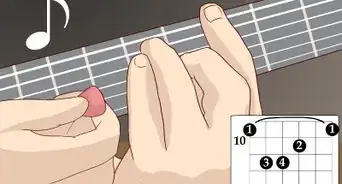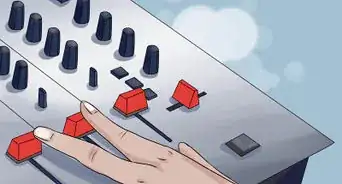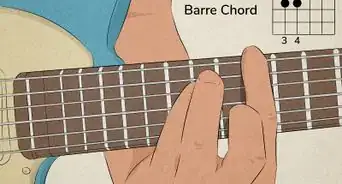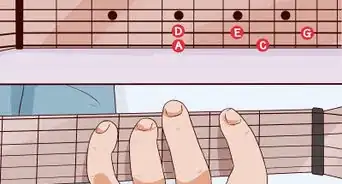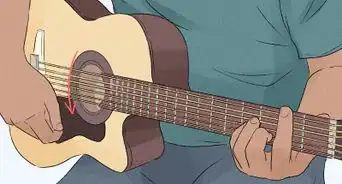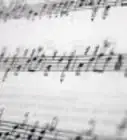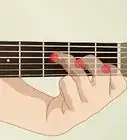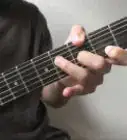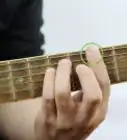X
This article was co-authored by Nate Savage. Nate Savage is a professional guitarist with over 16 years of experience teaching guitar to students around the world. His YouTube channel, Guitareo, has over 450,000 subscribers.
This article has been viewed 56,284 times.
An E7 is a deep, bluesy chord. Seventh chords are named because they add the 7th note of the major scale to the chord, giving the chord a darker, more blues-inspired tone. If you can already play an E-major chord, this should be easy. Even if not, the E7 is an easy chord to pick up.
Steps
Method 1
Method 1 of 2:
Playing an Open E7
-
1Leave the top string, the low-E, open. The thickest string on the guitar is the 6th string. Since it is an E, the root note of an E7, you can leave this string open.
- Remember that guitar strings count from the bottom up. The thinnest string is the 1st string, the thickest the 6th.
- Shortcut: If you already know an open E-major chord you simply have to remove one finger to get an E7. Remove your finger from the 4th string, leaving it open. This is an E7.[1]
-
2Place your ring finger on the 2nd fret of the A string. The fifth string, the A, is fretted at the 2nd fret. If you remember E-major, the form so far is the same for your E7.Advertisement
-
3Leave the 4th string, the D, open. This is actually the 7th note, but a higher octave of it than found in the major scale. If you don't care about the music theory, just leave this string open and move on.
- Make sure that your ring finger doesn't mute this string accidentally.
-
4Fret the G string on the 1st fret with your index or middle finger. This is actually the last note you need to worry about -- the rest of the strings are left open. Again, this is the same note used in an E-major.
-
5Strum all of the strings at once to play your E7. All you need to do is play an E7 are these two notes and the other open strings. That's it. Strum all the strings to sound out your bluesy chord. The final chord looks like this in tab:
- --0--
- --0--
- --1--
- --0--
- --2--
- --0--[2]
Advertisement
Method 2
Method 2 of 2:
Playing Barred E7 Chords
-
1Use your index finger to barre over the open-E7 form to make any chord a seventh. This only works for chords starting on the sixth string, but this makes it easy to play a seventh chord anywhere. Imagine that the open strings were actually a barred fret -- they are all the same "fret" being sounded out in your chord. This means your other two fingers will make any chord "barred" a 7th. Since the next E begins on the 12th fret, your E7 barre chord would look like:
- --12--
- --12--
- --13--
- --12--
- --14--
- --12--
-
2Learn an E7 barre chord on the seventh fret. When barring chords on the 5th string, you can use the same strategy to move your chord anywhere as the one used in the last step. However, you must use the form of an A7 chord, because an open A7 resembles a barre chord on the A string the same way an open E7 resembles a barre chord on the E string. For an E7, you'd start on the 5th string, 7th fret, an E, and play the following form:
- --7--
- --9--
- --7--
- --9--
- --7--
- --X--
- Note: If you moved this form all the way to the open strings, so you only fret the second string on the 2nd and 4th strings, this is an open A7 chord.
Advertisement
References
About This Article
Advertisement

